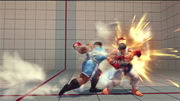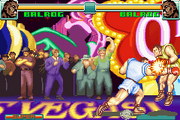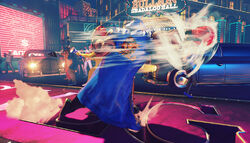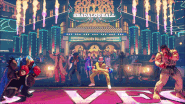(Adding categories) |
CammyRyona (talk | contribs) No edit summary |
||
| (13 intermediate revisions by 8 users not shown) | |||
| Line 1: | Line 1: | ||
| − | The '''Dash Straight''' |
+ | The {{Nihongo|'''Dash Straight'''|ダッシュストレート|Dasshu Sutoreeto}} is one of [[Balrog]]'s [[Special Attack|special attacks]], introduced along with him in the ''[[Street Fighter II]]'' series. |
| − | {| align="center" border="1" cellpadding="1" cellspacing="1" style="width: |
+ | {| align="center" border="1" cellpadding="1" cellspacing="1" style="width:215px;" |
|+'''Input''' |
|+'''Input''' |
||
|- |
|- |
||
| − | ! scope="row"|'''All appearances''' |
+ | ! scope="row" |'''All appearances''' |
| − | |[[Image:Arcade Stick CB.png|Charge backward]][[Image:Arcade |
+ | | style="text-align:center;"|[[Image:Arcade Stick CB.png|Charge backward|link=http://streetfighter.wikia.com/wiki/File:Arcade_Stick_CB.png]][[Image:Arcade-Stick-Right.png|Forward|link=http://streetfighter.wikia.com/wiki/File:Arcade-Stick-Right.png]]'''+'''[[Image:Arcade Button Punch.png|Punch|link=http://streetfighter.wikia.com/wiki/File:Arcade_Button_Punch.png]] |
|} |
|} |
||
==Description== |
==Description== |
||
| + | [[File:Dashstraight.png|thumb|Dash Straight hitting [[Ryu]] in ''[[Street Fighter IV]]''.]][[File:Dash_Straight.png|thumb|left|Dash Straight, as seen in [[Super Street Fighter II Turbo#Game Boy Advance|Super Street Fighter II Turbo Revival]].]] |
||
| − | + | Executed by charging backward, then pressing forward and punch, Balrog performs a simple dash forward and follows-up with a straight punch using his opposite fist, with an accompanying "rush of wind" background sound effect. |
|
| ⚫ | |||
| ⚫ | The speed and distance traveled are determined by the punch button pressed |
||
| ⚫ | |||
==Tactics== |
==Tactics== |
||
| + | [[File:DashStraight.jpg|thumb|250x250px]] |
||
| ⚫ | The |
||
| + | This move can be treated as one of Balrog's best pokes. Essentially, Dash Straight can be used as a fireball. Properly spacing the dash punches is crucial to Balrog's neutral game. While they are unsafe at point-blank range, this attack is an effective and safe way to apply pressure, deal chip damage and stuff out many normal attacks. Even though this move doesn't result in a knockdown, Balrog gets positional and frame advantage on hit. This allows him to maintain offensive pressure or mix up throws to keep his opponent guessing. |
||
| ⚫ | The speed, damage, and distance traveled are determined by the strength of the punch button pressed. The Light version has the fastest startup, but covers only about a third of the stage's length. It also deals the least amount of damage. The Medium version deals slightly more damage than the Light version. It also reaches around half the stage in length, though the punch takes longer to come out. The Heavy version travels almost the whole stage and inflicts the most damage. However, it has the longest startup. |
||
| ⚫ | |||
| ⚫ | The Ligh version is the hardest to predict the safest on block if spaced correctly.. The Medium version is generally considered the best variation for its passable distance and decent punch lag. The Heavy version, while naturally being the strongest version and considered the best for retreating foes, it is also the most predictable, and easily taken advantage of with a fairly quick reaction. |
||
| ⚫ | |||
| + | |||
| ⚫ | |||
| ⚫ | |||
| + | |||
| ⚫ | |||
[[File:Balrog-longpunch.gif|Street Fighter II series]][[File:Balrog-cs-punch.gif|SvC Chaos: SNK vs. Capcom]][[File:Balrog-punch-lunge.gif|Street Fighter Alpha 3]] |
[[File:Balrog-longpunch.gif|Street Fighter II series]][[File:Balrog-cs-punch.gif|SvC Chaos: SNK vs. Capcom]][[File:Balrog-punch-lunge.gif|Street Fighter Alpha 3]] |
||
| + | |||
| ⚫ | |||
| + | <gallery> |
||
| + | DashStraight.gif|Balrog's Light, Medium, Heavy, and EX Dash Straight in ''Street Fighter V''. |
||
| + | </gallery> |
||
| + | |||
| + | {{Boxer1}} |
||
[[Category:Attacks]] |
[[Category:Attacks]] |
||
[[Category:Special Attacks]] |
[[Category:Special Attacks]] |
||
| Line 28: | Line 39: | ||
[[Category:EX-able Attacks]] |
[[Category:EX-able Attacks]] |
||
[[Category:Charge Attacks]] |
[[Category:Charge Attacks]] |
||
| − | [[Category: |
+ | [[Category:Super Charge Attacks]] |
| + | [[Category:Attacks with Follow-Up]] |
||
Revision as of 04:42, 1 July 2020
The Dash Straight (ダッシュストレート Dasshu Sutoreeto?) is one of Balrog's special attacks, introduced along with him in the Street Fighter II series.
| All appearances |
|---|
Description

Dash Straight hitting Ryu in Street Fighter IV.

Dash Straight, as seen in Super Street Fighter II Turbo Revival.
Executed by charging backward, then pressing forward and punch, Balrog performs a simple dash forward and follows-up with a straight punch using his opposite fist, with an accompanying "rush of wind" background sound effect.
The EX Special version introduced in Street Fighter IV has Balrog dash the entire stage length and gain Super Armor, but its default damage value remains unchanged. In Street Fighter V the EX version has Balrog perform two consecutive punches on hit.
Tactics

This move can be treated as one of Balrog's best pokes. Essentially, Dash Straight can be used as a fireball. Properly spacing the dash punches is crucial to Balrog's neutral game. While they are unsafe at point-blank range, this attack is an effective and safe way to apply pressure, deal chip damage and stuff out many normal attacks. Even though this move doesn't result in a knockdown, Balrog gets positional and frame advantage on hit. This allows him to maintain offensive pressure or mix up throws to keep his opponent guessing.
The speed, damage, and distance traveled are determined by the strength of the punch button pressed. The Light version has the fastest startup, but covers only about a third of the stage's length. It also deals the least amount of damage. The Medium version deals slightly more damage than the Light version. It also reaches around half the stage in length, though the punch takes longer to come out. The Heavy version travels almost the whole stage and inflicts the most damage. However, it has the longest startup.
The Ligh version is the hardest to predict the safest on block if spaced correctly.. The Medium version is generally considered the best variation for its passable distance and decent punch lag. The Heavy version, while naturally being the strongest version and considered the best for retreating foes, it is also the most predictable, and easily taken advantage of with a fairly quick reaction.
In addition, every variation can be easily countered with another move (specially projectiles), unless mitigated by the EX version's Super Armor.
Sprites
Gallery
| Balrog's Move List | |
|---|---|
| Throws | Head Bomber • Lever Break • Dirty Bomber • Dirty Shot |
| Unique Attacks | Charge Up • Under Impact • Hard Smasher • Hard Pressure • Stomping Combo |
| V-Skills | KKB • FFB |
| V-Reversal | Buffalo Head |
| V-Shift Break | Buffalo Breaker |
| V-Triggers | Crazy Rush • No Mercy |
| Special Attacks | Dash Straight • Dash Upper • Turn Punch • Buffalo Head • Dash Low Straight • Dash Low Smash • Screw Smash • Horn Breaker • Wild Smash • Dash Low Upper • Reflect Glove |
| Super Combos | Crazy Buffalo • Gigaton Blow • Dash Ground One-Two |
| Super Arts | Crazy Buffalo |
| Ultra Combos | Violent Buffalo • Dirty Bull |
| Critical Arts | Gigaton Blow |
| Exceed | Ultimate Wild Smash |




